On 2 December 2019, PwC Legal and BRYTER co-hosted the book launch of “New Suits. Appetite for Disruption in the Legal World” at the Deutsche Bank Q Club in Berlin. Following the welcome note, some of the book’s authors took the stage to discuss their respective chapters and take questions.

On 2 December, BRYTER and PwC Legal co-hosted the book launch of “New Suits: Appetite for Disruption in the Legal World” at the Deutsche Bank Quartier Zukunft’s Q Club in Berlin. The textbook was co-edited by Michele DeStefano (Professor of Law at the University of Miami) and Guenther Dobrauz (Managing Partner of PwC Legal Switzerland), and published by Staempfi Verlag.
To kick off the evening, Guenther Dobrauz gave an introductory speech on the book and digital transformation of the legal world in general. He shared his thoughts and insights into the theory of innovation, as well as current developments within the global legal market; Guenther reminded us of both the challenges and opportunities awaiting lawyers in the years to come. In particular, he demonstrated that the legal industry faces unprecedented change.
After Guenther, authors from the book’s other chapters took the stage to present the key points from their respective chapters. Once the talks were concluded, attendees were able to mingle with the book’s authors over some drinks and snacks. Many of Berlin’s legal innovation community were present and the discussions that followed were spirited and insightful.
New Suits: Appetite for Disruption in the Legal World
New Suits presents a global perspective on the diverse legal operations delivery ecosystem that the future will bring. It consists of contributions from over 40 renowned theorists and legal practitioners and explores emerging technologies, new business models, and changing client expectations.
Although the future requires us to put on ‘new suits’ — it represents an enormous opportunity for lawyers to reinvent ourselves for our own and our clients’ benefit.
Foreword from the book ‘New Suits’
Written by experts in the intersection of law, innovation, and technology, each chapter explains why lawyers can and should increase their appetite for disruption in the legal world. Throughout the book, authors take the reader through the uncharted waters of the future legal realm while inspiring them to contribute to and participate in the evolving field of legal services.
The book begins with a foreword from the curators and is divided into three parts:
- Part 1: Why Do Lawyers Need New Suits?
- Part 2: What New Suits Might Lawyers Need for the Future?
- Part 3: How Will Lawyers Fit into The New Suits of the Future?
Keynotes from the authors
Following the welcome note, some of the book’s authors took the stage to discuss their respective chapters and take questions.

Guenther Dobrauz
Guenther co-edited the book, co-authored two chapters “Innovation, Disruption, or Evolution in the Legal World” and “Strategic Mapping of the Legal Value Chain” and is a Managing Partner at PwC Legal. Prior to PwC, he was a venture capitalist, served as in-house counsel at an international hedge fund, and practiced in court and with a leading business law firm.

Guenther hosts the educational video series “Appetite for Disruption”, is the founder of global technology enthusiasts’ movement “Disruption Disciples” and is a permanent member of expert groups at economiesuisse. Thanks to his diverse background, Guenther brings diverse perspectives to the table, which were presented during his talk. Guenther opened his keynote with a Burning Man Festival quote:
The appropriate response to new technology is not to angrily retreat into the corner hissing and gnashing your teeth.
It is to ask: Okay, how should we use this?
He discussed the concept of innovation in general and took his audience through the horizons of technological disruption and remarked on the speed in which technology is adopted in modern times:
It took about 75 years for the telephone to connect 50 million people. Today a simple iPhone app like ‘Angry Birds’ can reach that milestone in a matter of a day.
Guenther Dobrauz
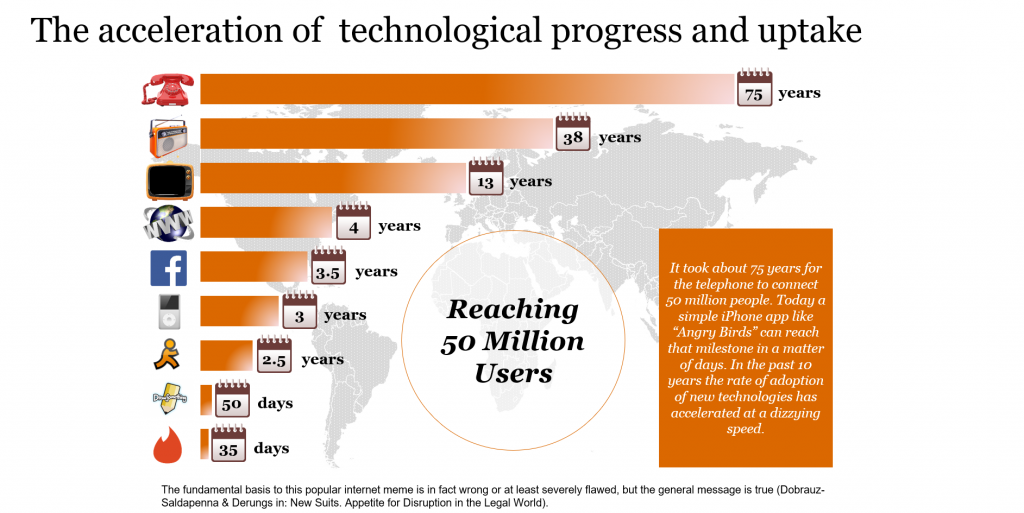
Law in the Exponential Technologies Age”, given by Guenther Dobrauz, December 2nd, 2019.
He highlighted the fact that the rate of adoption of new technologies has increased. Before, innovation cycles were slow, nowadays they can take the shape of veritable “waves” that are fast, intense and prevent roadblocks in the process.
Across the economy, there are many efforts to convert artisanal processes into workflow automation — a trend that has not escaped the legal industry. He discussed the concept of disruption: is it even possible in law? Is there such a thing as disruptive innovation for lawyers? (a concept later responded to by Michael Grupp, who highlighted “new attack vectors” of legal service delivery in the area of automation).
Guenter stressed the need for law firms to test, adapt, and move quickly, which has important consequences for legal teams: From pyramid to rocket.
He closed his keynote by illustrating how the pyramid model, the de facto operational model of most law firms, will be replaced by a “rocket-like” structure with technology managers and support from Legal Tech companies.
Tom Brägelmann
Tom Braegelmann, author of the chapter “Restructuring Law and Technology”, is an experienced international restructuring practitioner. Tom has a dual legal qualification (Germany, USA) and has worked as an international business lawyer for major international law firms in Germany, specializing in international restructuring matters.

During the second half of 2017, Tom was General Counsel at Legal Tech company, Leverton. He is closely following the latest technological developments transforming the legal sector, namely the digitization of restructuring and insolvency practices worldwide. He is one of the most prominent voices on legal innovation, distributed ledger concepts, and data in law.
Tom’s presentation was all about “dirty data”. While lawyers think that they have good data (e.g. in the form of official documents), this data needs to be structured (formalized, cleaned, annotated) to be used. He introduced a few ways to go about structuring data, such as through formalized processes (forms, organizational measures, or through dedicated tools like BRYTER) or through manual effort, all of which require dedicated resources and effective ROI. He exemplified the concept of structured data within blockchain or DLT-based applications, as these technologies familiarize users with formalized data. The core message of his presentation:
We need to structure data better in order to work with it at all.
Tom Brägelmann
Silke Graf
Silke oversees “Legal Tech & Knowledge Management” at PwC Legal Austria and advises in the areas of data protection law and industrial property rights. Before joining PwC Legal, Silke worked at a renowned Viennese boutique law firm and most recently gained experience in companies that develop software for the legal industry. Due to her engagement in the field of Legal Tech, she was recognized as one of the “Woman of Legal Tech 2018” (organized by Hogan Lovells and BRYTER) for Austria, Germany, and Switzerland. She co-authored the chapters “Lawyer Bots” and “Automated Legal Documents”.

In her keynote, she shared insights and learnings from several innovation projects she has led. Using the example of “lawyer bots”, she highlighted the scope of legal innovation and the adoption of technology. Lawyer bots are not voodoo magic, they are for the most part rule-based auto-response systems; complex machine learning concepts, like natural language processing (NLP), are still in their infancy and not yet being used at scale within the legal space.
For several reasons, true AI concepts lack transparency and are still limited in their scope. One of them: the lack of structured data, the importance of which was previously noted by Tom Brägelmann (see above).
Lawyers need to adapt to change and get used to the rapidly changing world around them. Innovation is not slowing down. Therefore, lawyers need to understand which wave to take, how to take it, and what to do. This is a core learning.
Using the example of document automation, she showed how law firms and legal departments compare when it comes to adopting new technologies.
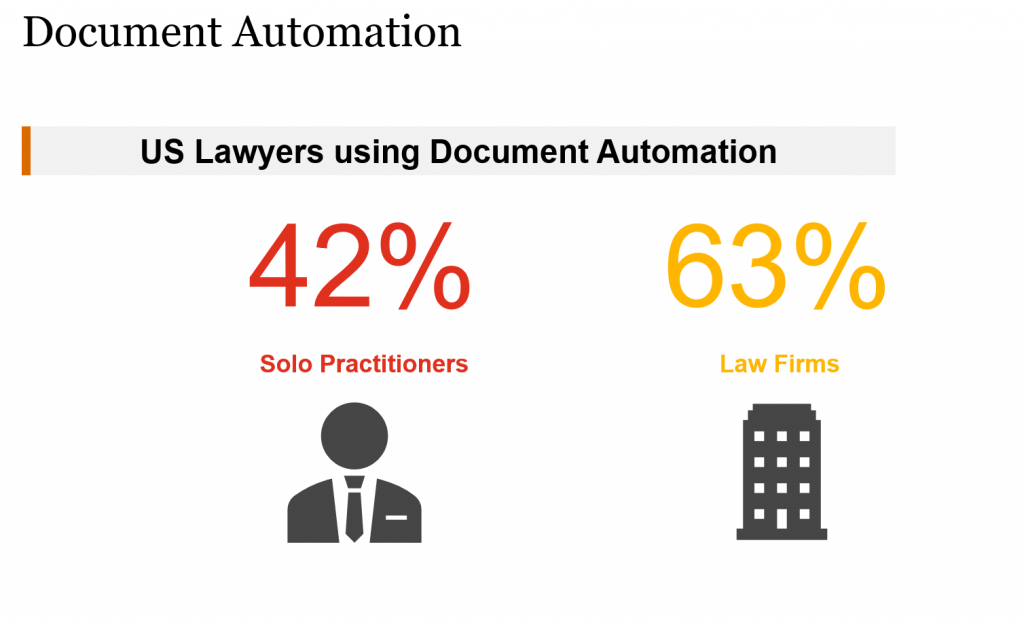
In Austria, these numbers are significantly different. While lawyers in private practice are adopting document automation at a comparable rate of close to 60%, only 10% of lawyers in corporate legal departments have adopted document automation.
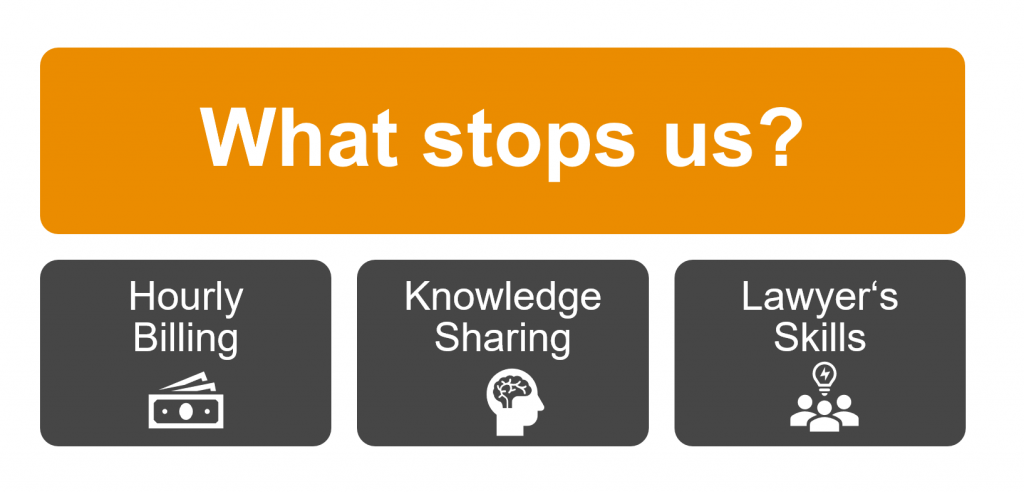
She closed her presentation by highlighting the importance of asking the question: “What is holding us back?” Pointing out three key factors: Hourly billing, lack of knowledge sharing and a digital skills gap.
Michael Grupp
Michael Grupp is the CEO & co-founder of BRYTER, a member of the Bucerius Executive Faculty and the German Association of Lawyers DAV e.V. Legal Tech taskforce, and a lecturer on legal technology and innovation at the Frankfurt University. He co-authored a chapter on no-code automation with BRYTER CCO and fellow Bucerius Executive Faculty member, Micha-Manuel Bues.
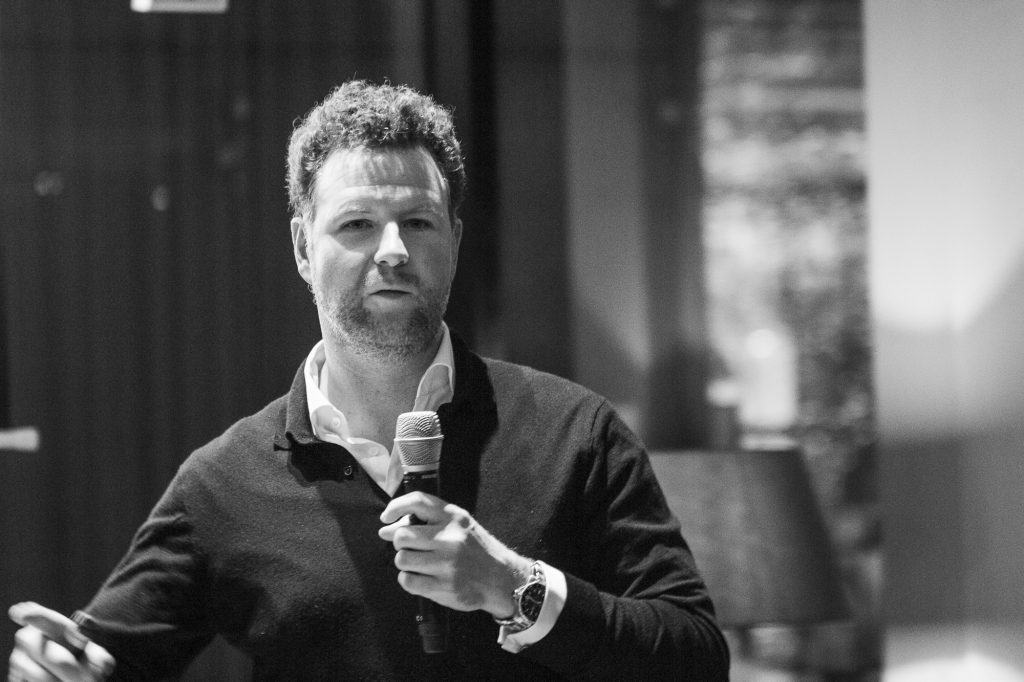
Michael’s presentation was titled “50 Years of Automation: What we learned from the past and where we are going now”. Due to time constraints, Michael reduced his presentation to focus on two core messages:
Most of the things that are working now have been researched before (and most of the things currently being hyped have already been previously debunked).
The legal Industry needs to adopt (feasible) service automation concepts in order to participate in an increasingly automated world that threatens the legal industry through indefensible attack vectors.
In a brief introduction, he showed that the 1960s and 1970s had already surfaced most of the available opportunities in technology. Automation as a concept has been applied to legal and regulatory content in various formats: Expert Systems, Rule Engines, Fuzzy Logic, early concepts of machine learning. He emphasized:
We know what works and what does not. Our job today is to re-examine how modern concepts of technology and overall tech adoption have given new grounds for this tech: Biggest example here is the cloud, that – as a paradigm change for all software delivery – facilitates adoption, sales, delivery and implementation; that was still unimaginable for 1980s technology.
Michael Grupp
He showed that we are living in times of great heterogeneity in technology adoption and feasibility: while some sectors are fast in adopting technology like chatbots for business, where numeric and structured data is easily available and widespread, in other fields —like law — tech is lagging. And the hype creates a distorted image of what is possible.
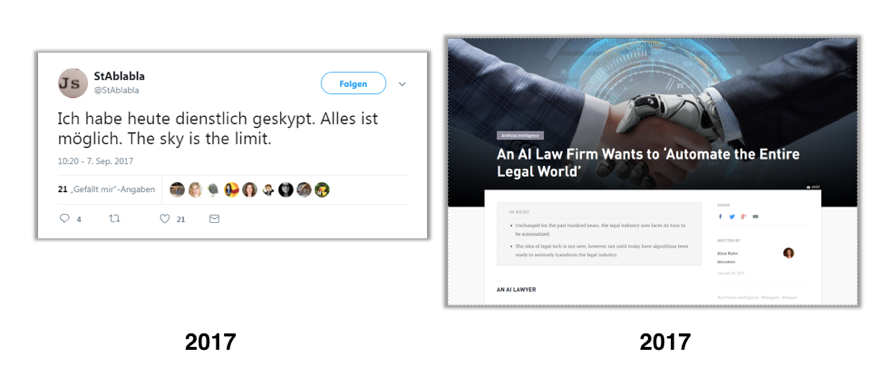
In an overview of automation concepts, Michael gave examples of how other industries are making progress with automation. Though automation as a concept is seeing widespread adoption, it is often viewed as “boring” and not widely discussed.
However, broad organizational digitization is forcing legal units to participate and to collaborate using technology. When automation is not adopted — because corporate legal or compliance is slow, uninterested or just unorganized — there is a risk the legal unit will be “circumvented” by workflows and processes that deliver faster and cheaper solutions. Here, the emergence of ITSM (IT Service Management) and ESM (Enterprise Service Management), as well as increasing levels of automation within organizational processes, demonstrate the need for “semantic areas” to catch up or be left out.
Matthias Schwenke
Matthias Schwenke is a partner at the PwC Legal Frankfurt Office and was deeply involved with legal innovation topics as the former head of Axiom Germany.
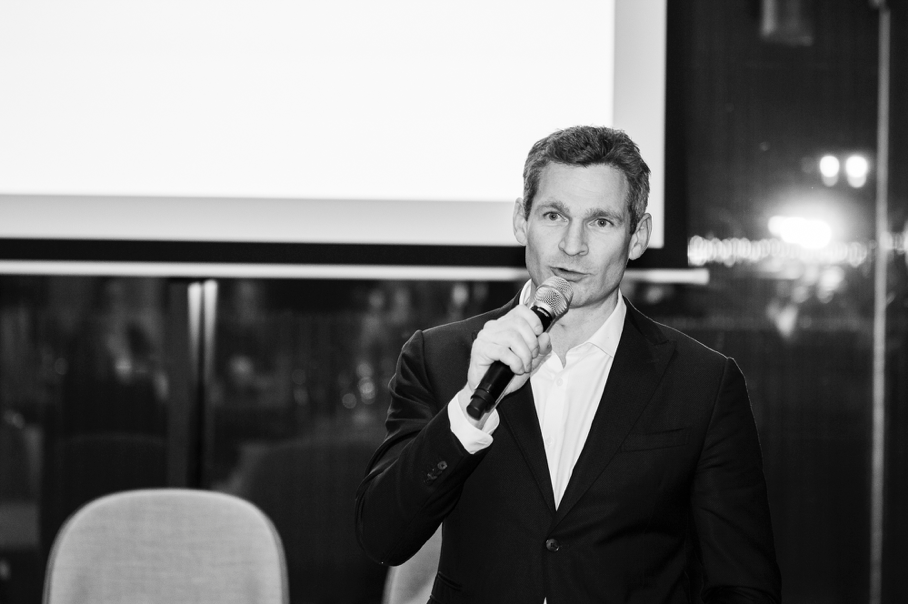
He began his talk by highlighting key developments in the legal market: customers are becoming more demanding and price-sensitive and there is a differentiation between “highly specialized” and “highly efficient”.
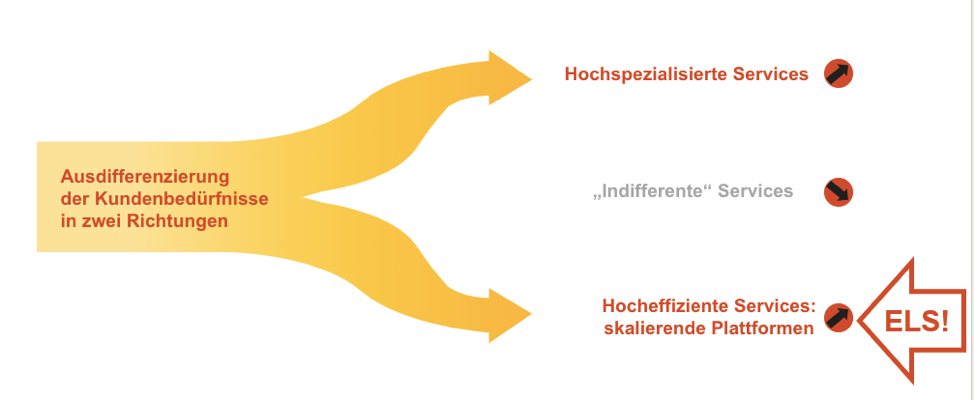
He highlighted the importance of holistic concepts: technology needs to be accompanied by a subset of strategies and measures. He stressed the fact that successful solutions lie in the process, not in the minds of the individual service providers.
The concept of People-Process-Technology outlines the need for companies and firms to have a 360-degree approach to integrating people and processes in tech adoption. There is no magic pill. The adoption of legal tech is not a solution in and of itself. Neither are changes to organization structure or workforce, without tech adoption. People, Processes and Tech need to be collectively considered to be able to develop right-fit, efficient solutions.
The bottom line: first, do the homework — take legal workflows apart, simplify and standardize them. And as with any service, it is crucial to work out what the customer really wants.
Philipp Rosenauer
Philipp is a senior manager with PwC Zurich and a member of its Legal FS Regulatory & Compliance Services practice. In his position as head of the Legal Function & Legal Strategy Advisory, Philipp focuses on disruptive innovation in the LegalTech and RegTech space. He is responsible for managing large scale legal regulatory projects. As a legal expert in the financial services industry, he assists banks, asset managers, traders, and insurance companies in complying with Swiss and EU financial regulations. Besides that, Philipp is a permanent lecturer at the University of Liechtenstein.

Together with Guenther Dobrauz and Steve Hafner, he is driving the LegalTech and Managed Legal Services topics at PwC Legal Switzerland. He co-authored the chapter “From Legal Process and Project Management to Managed Legal Services (MLS)”.
During his talk, he explained how Legal Tech will change the way lawyers interact with clients in the future and the impact on the work style lawyers were used to for decades. Legal Tech is not a threat for lawyers — it is a great opportunity.

Firms need to embed best in class technology within their legal processes and will need to innovate continuously as better software tools are developed. The work will still be led by people but augmented by technology. The full-service law firm of the future, he explained, will have a more diverse business model in which their offering will expand to include consulting, forensics, and risk mitigation services.
Philip dug into the concept of Legal Technology, stating:
The concept behind “Legal Technology” basically does not describe a new phenomenon, but instead refers to the application of technology and software for administrative support in law firms.
Philipp Rosenauer
Nevertheless, the Legal Tech concept has evolved in a direction where start-up companies are associated with the term. Those start-ups enable their users to handle certain legal matters without any personal interaction with a lawyer. Especially in the area of compliance, there is a wide range of use cases for Legal Tech applications.

Philip guided the audience through the status quo of Legal Tech service providers and set out considerations that can help inform the creation of a fit-for-growth operating model for a legal function. He closed his presentation by sharing key elements for the development of a successful Legal Tech strategy.
It was an insightful night! Thanks to all of those who attended and to the amazing speakers. If you are looking to easily build without programming skills using a visual “drag-and-drop” interface, please do not hesitate to book a demo to learn more about BRYTER no-code platform.
About BRYTER
BRYTER is the no-code app builder that enables business experts to build digital apps. BRYTER gives enterprise teams the tools to build digital applications to provide faster, more accurate services to their colleagues, without programming. BRYTER is especially geared to professionals in law, compliance, accounting and finance, who use workflow automation and no-code to streamline complex, recurring decisions and scenarios. Global brands from consumer industries (McDonald’s), through financial services (ING Banking Group) to professional service firms (Deloitte, PwC and KPMG), use BRYTER to deliver services digitally. BRYTER is a remote-first company with offices in New York, Boston, London, Paris, Frankfurt and Berlin. www.bryter.com